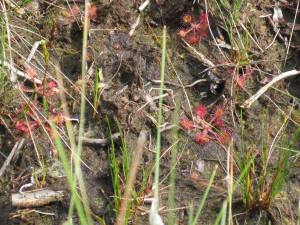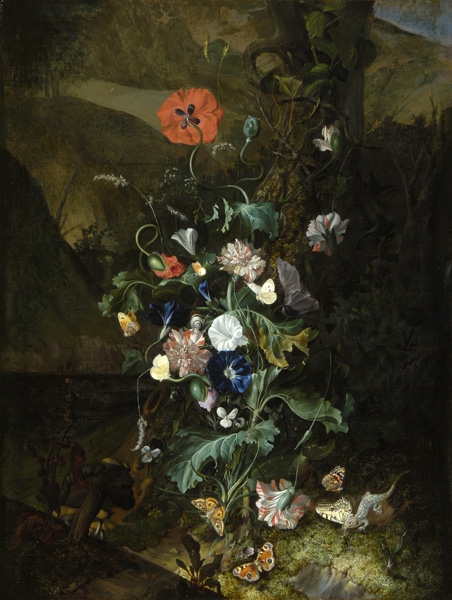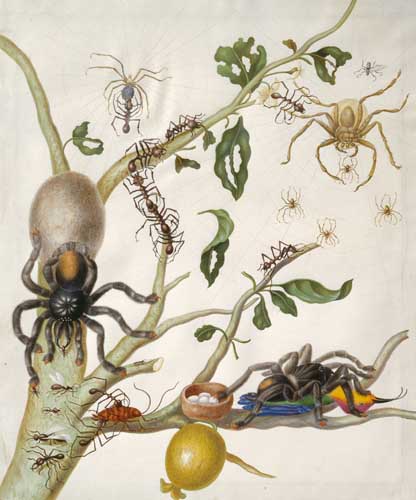The 5th blog by ‘Ruth Kowslowski’, chapter 25 in The Embalmer’s Book of Recipes
There are many ways of killing flies, but the extreme solution of first swallowing a spider is certain to cause discomfort.
Spiders – the non-bird-eating species – have evolved a variety of web-designs for snaring their prey. Much as a sea-trout swims into a net fixed across the mouth of a stream, so might a fly be caught, and held tightly by minute globules of glue. After a quick paralysing bite, the spider packages up the helpless creature in a silk winding-sheet. The sundew plant uses sticky globules too but its treatment is less aesthetic, the edges of its scarlet-fringed leaf curl over the insect, imprisoning it so that it stops wriggling and dies, and gradually, very gradually, its body is digested. All that remains on the web or in the sticky leaf is an empty husk, the insect’s scarcely recognisable, undigested exoskeleton.

Entomologists and butterfly collectors need their dead insects to be whole and unharmed. Gaseous carbon dioxide, freezing, fumes of chloroform or nail polish remover, or pickling in alcohol or formalin, the methods all have their advantages and drawbacks. To make a Killing Jar: place a layer of ten finely-chopped laurel leaves in the bottom of a honey-jar and screw the lid on tightly, to capture the marzipan fumes of hydrogen cyanide.
Kill and arrange aesthetically in your cabinet. Admire – and mourn. Cherish the memory.
Unlock and fold back the polished wooden bar on its bright hinges and slide out the shallow drawers, one by one. Look at the hundreds of beetles, thousands of green-eyed flies, their bodies pinned onto cork, the tiny labels with name and place and date. The ‘Type Specimen’, the acknowledged example of its kind, and dozens of variants with minute mutations and alterations. It’s like stamp-collecting, you must check the number of perforations, the graded colours of the patterns. But the modern collector does not merely tick the box but prefers to ask ‘how?’ and ‘why?’. The modern taxonomist deals in molecules not just in external signs, and seeks the remnants of genes in mummified or pickled corpses, or from the blood-meals of mosquitoes preserved in the sticky exudations of trees.
The Dutch anatomist and botanist Frederik Ruysch was a collector of insects as well as foetuses and curious natural objects. Insects symbolised the transiency of life on earth, the beautiful butterfly bursts forth from its papery brown pupa-case but lives for a few short weeks (unless it has the wit, or inbuilt programming, to hibernate). Adult Ephemeroptera, the mayflies, live for a single day, escaping one medium into another, from water to air, to fly and mate. Brief encounter, brief lives!
Ruysch’s moralistic and allegorical tableaux on the theme of death now exist only as engravings (drawn ‘from life’ by Huyberts) in the large leather-bound volumes of his Thesauri Anatomici, his Omnia Opera. Insects, bones and anatomical curiosites share the stage. The skeletons of foetuses stand or lie in different postures, amongst pebbles and kidney stones and taxidermal preparations of birds and other animals, arranged artistically on ornate wooden stands. In the tableau depicted in Thesaurus VIII, dried blood vessels project upwards as a forest of branches, a skeletal arm waves a scroll of paper, and two foetuses weep into lacy handkerchief of dried mesenteric tissue. Well might they weep, for the hollow rock beneath them is a dried injected uterus, cut and opened like the door of the Tomb to show the dead embryo inside. ‘A Fate, ah bitter fate!’ sings the foetal skeleton in Thesaurus III, as it accompanies itself on a malformed bone ‘violin’ with a dried artery for a bow. Its grinning companion encircles itself around with a snake of injected sheep gut, the vase-like form of an inflated testis adds artistry and elegance, and in the foreground a prostrate tiny skeleton holds an adult mayfly.
Her father’s collections provided a handy source of specimens for Rachel Ruysch. Moths and butterflies, grass-hoppers and flies rest amongst the richly-coloured, richly-textured flowers in her still-life paintings. A lizard, a frog, snails with striped shells – the invertebrate creatures have such depth and colour as to seem alive, halting briefly for a single moment in time. No other artist could capture the texture of velvety petals and reflections on the damp bloom on grapes so well as Rachel Ruysch.She became famous, her works were much sought-after, and in 1708, aged 44 years old, she was appointed Court Painter to the Elector Palatine of the Jülich-Berg duchy, Johann Wilhelm. She and her husband Juraien Pool stayed at the court in Düsseldorf until the Elector died.

In Arrangement of flowers by a tree-trunk, in Glasgow’s Kelvingrove Museum, six different butterflies and moths fly amongst the flowers, one drifting down to alight on a pure white trumpet of convolvulus, another fluttering vainly between the flat jaws of a lizard. But these insects, unlike her father’s specimens, are not moralising statements for they exemplify reality, their details have been observed and recorded, and are offered to us in all their glorious detail.
In 1697, Peter the Great, aged 25 years old, worked in an Amsterdam shipyard and attended Frederick Ruysch’s anatomy lectures. Peter enjoyed carving and joinery, he liked to work in wood and stone and human flesh, he even fancied himself as a bit of a dentist and a surgeon. His portrait was painted in Amsterdam by Jan Weenix, who later painted twelve large murals for the Elector Palatine. Perhaps Rachel sometimes stopped by to watch and advise: ‘Put a deer-fly or two on that stag’s skin.’
The portrait painter Godfried Schalken overlapped with Weenix in Dusseldorf in 1703 although not with Rachel Ruysch, but he had already painted her portrait in Amsterdam. In her late thirties she still has the same long straight nose but now she also has a double chin and lace at her bosom.
In 1699, a year after Peter left Amsterdam, boasting that he had bought his new boots with the proceeds of his work, Maria Sybilla Merian (1647-1717) visited Frederik Ruysch’s house to study his insect collection. She wanted to learn about insects, their metamorphoses and lives, and that same year she took her youngest daughter Dorothea and went abroad, to Surinam. She saw how caterpillars pupated into chrysalids from which a moth or butterfly crawled out, damp and crumpled, and spread its wings. She watched insects, she collected them, she wanted them alive as well as dead, and she painted their life-cycles and their food-plants.The details were as scientifically exact as the glass insects and flowers of the Blaschkas’ series on insect pollination. The colours glowed.
Thirty years previously the Leiden anatomist, Jan Swammerdam, famously dissected a preserved caterpillar for Cosimo de Medici. Swammerdam, according to the naturalist Boerhaave, wanted to preserve parts of the dissected body in constant readiness for anatomical demonstrations, freeing him ‘from the difficulty of obtaining fresh subjects, and the disagreeable necessity of inspecting such as were already putrified’. He, like all the other Leiden experimenters in embalming, used oil of turpentine (at that time, the distilled resin of the terebinthe tree, Pistacia): take a tin vessel large enough to hold the corpse or dissected organ, and place a grid in it two fingers’ width above the bottom; pour in oil of turpentine to three fingers’ width, place the corpse inside and cover the vessel tightly with a lid. An embryo requires two months, a spleen ten days, a liver one month. Swammerdam preserved the body of a month-old child – and a whole lamb.
The oil of turpentine converted the body fats of insects into a harder limey substance which could be washed away, leaving fibrous tissue intact. Inside Swammerdam’s dissected caterpillar de Medici saw the wings of the future butterfly, and saw too that metamorphosis was an unfolding of parts already present rather than an alchemical change. Swammerdam turned down de Medici’s offer of 12,000 guilders for his insect collection.
Houbraken’s engraving, taken from a portrait (dating from 1700) by George Gsell, portrays Sybilla Merian with shells and plants around her. She died in Amsterdam at the age of 70 and that same year, 1717, Peter the Great returned to Amsterdam and bought not only most of Frederik Ruysch’s great collection of tableaux, ‘naturalia’, embalmed babies and decorated foetuses, for 30,000 guilders, but also the late Sybille’s Metamorphosis Insectorum Surinamensis and part of her insect collection.
Images from Wikiwand
He also acquired Sybilla’s daughter Dorothea, persuading her to use her skills to design the decorations around his new collection in the Kunstkammer.
Her husband (and Sybilla’s son-in-law) Georg Gsell, went too, and when the giant footman Bourgeois died in 1724, Georg painted him – posthumously – so that his fleshly appearance was preserved in a portrait before he was boiled.
Rachel Ruysch was long-lived like her father, and painted her last still-life at 83 years old, in 1749, less than a year before she died. In one of her paintings a caterpillar hangs by a thread. In Merian’s drawings from Surinam, caterpillars munch holes in leaves, spin silk around themselves to form protective cocoons, or their skin hardens and changes shape to form a pupal case or chrysalis. Inside the pupa, as Swammerdam had seen, organs and appendages shrink or grow, change shape, wings sprout, and antennae.
But now we know that parasitic wasps may lay their eggs in living caterpillars, eggs which hatch into larvae that devour the caterpillar’s tissues from inside, the wasp larvae growing, moulting, themselves changing shape until they burst out, leaving an empty husk behind them. Did Merian and her daughter observe this metamorphosis of aliens, this apparent transmutation of species? The caterpillar as host, the food-provider, the life-support system, the container for a new life-form.
So also some modern matryoshki, variants of the wooden nested Russian dolls. The traditional dolls with rosy cheeks and peasant scarves, one inside another, date from the late 1800s, long after Peter the Great practised his own wood-turning skills. The mother figure is a symbol of birth and renewal, the handing on of the lineage and the mitochondrial genes. But modern versions of the matryoshka escape the human form, so that a cow contains a sheep, which contains a pig, a chicken and, of course, an egg. The outer form hides its inner secret wherein one species generates another.
The recipe for an Elizabethan dinner does this too, but in reverse for it symbolises death rather than birth. It omits the mammals and sticks with our feathered friends. ‘Take a boned swan, stuffed with a boned goose, stuffed with a boned capon, stuffed with a boned muscovy, followed by a boned pheasant, then a partridge, a woodcock and a dove, stuffed with a boned snipe, a boned sparrow and a dozen lark’s tongues.’
As for that old lady who swallowed a fly, she took in the whole range from mammals to invertebrates:
There was an old lady who swallowed a cow.
I don’t know how she swallowed a cow!
She swallowed the cow to catch the sheep…
She swallowed the sheep to catch the dog…
She swallowed the dog to catch the cat…
She swallowed the cat to catch the bird …
She swallowed the bird to catch the spider
That wriggled and jiggled and wiggled inside her.
She swallowed the spider to catch the fly.
But I dunno why she swallowed that fly
Perhaps she’ll die.
And as for the old lady who swallowed a horse, what did you expect? ‘She’s dead, of course.’









